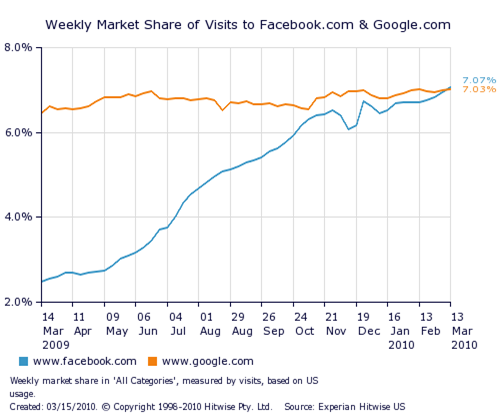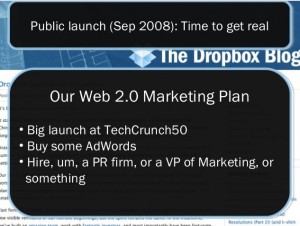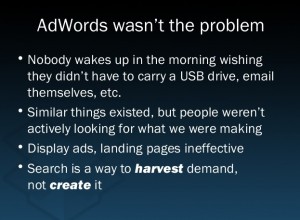Online advertising trivia 101.
How much does Google make a year?
A lot.
Why? Their stuff is really good, and they have lots of it.
Second question, how about did Facebook make?

So one might conclude, does Google have way more traffic than Facebook’s traffic?
Nope. They have about the same. And it looks like Facebook is going to exceed the amount of traffic that Google gets on its properties.
So what the HECK happened.
Same amount of traffic yet only a fraction of the revenue?
What’s going on here?
Simple: demand GENERATION vs. demand FULFILLMENT.
No TWO traffic source qualities are ever the same.
Que es demand generacion vs. demand fulfillmente?
(Ok, my spanish is rusty.)
What’s the difference, you ask?
Demand generation – People don’t know who you are. They discover who you are (company, product, idea, service, trend, news, organization, etc.).
Demand fulfillment – People know you you are. They are looking for you.
Thus…
Demand fulfillment cannot precede demand generation because people wouldn’t know what to look for or what search terms to use.
Makes sense, right?
How would you know about a product if you’ve never even HEARD of it?
If you’ve never even heard of it.. what would you enter into the input box into a search engine?
Demand generation (s awareness, and demand fulfillment is satisfying the demand (for more knowledge). When people say “lead generation”, they’re actually being vague because they’re not asking which.
And of course, if you are aware, there is a HIGHER chance that the visitor has the desire to purchase (assuming the product/service is commercial in nature).
Certain sites are more on the demand fulfillment side than others..
Here’s an excerpt of an interview with Sheryl Sandberg, the CFO for Facebook (src):
Q: You’ve said Facebook’s sweet spot is the top of the marketing funnel–that is, ads that create awareness and consideration of a brand, rather than direct marketing. Is that turning out to be true?
A: It’s demand generation. We’re not really demand fulfillment, when you’ve already figured it out what you’re going to buy–that’s search. We’re demand generation, before you know you want something, before you know you’re interested in something.
Q: Yet it seems like most of Facebook’s ad business is really not branding yet–it’s more direct-response-oriented by advertisers that are looking for a fairly overt result, like getting an email subscription for a daily deal or trying out a social game.
A: I don’t want to mix up wanting a direct answer with demand generation. (She approaches the whiteboard.) This is the marketing funnel. This part is what advertisers refer to as intent (in the middle of the funnel). Demand generation is above this, and demand fulfillment is below. Up here (at the top of the funnel) is awareness, and then you go all the way down to purchase. What every advertiser wants is this (she circles “purchase” in red). The question is, where do you begin?
When you see advertisements on Facebook that want a response, I still think they’re demand generation. But they’re trying to get you here (she points to “awareness” at the top of the funnel). In other words, they’re taking you all the way from here (awareness) to here (purchase) in one ad or one experience. They don’t believe you got on the site looking for what they’re selling. When you go to search, you’re “OK, shower curtain. Looking for shower curtain.” You already have intent, I’m going to take you to purchase.
If I saw a shower curtain on our site, no one thinks I’m searching for shower curtains. It’s more that a friend bought a shower curtain. If I see an ad for Sprinkles cupcakes, I’m not looking for dessert. So there’s still demand generation. Demand generation does not mean you don’t want action. It just means you’re starting here. You’re trying to generate awareness.
Case Study: DropBox
When DropBox came out, no one had any idea what it was.
Especially those in non-tech industries.
So how did the founder of DropBox tackle the problem of distribution when he first made the product?
He tried search engine marketing… and failed miserably
So how did the DropBox team solve this problem?
Simple: a really easy to use product and growth hacking.
Why Demand Fulfillment = $$$
Where does the demand fulfillment (i.e. search) actually occur?
BINGO… SEARCH ENGINES.
This is WHY search engines make EXPONENTIALLY more than media sites because the intent to purchase is WAY better.
Because odds of you deciding to buy on FIRST exposure is fairly small repetition and followup can increase your chance of selling).
So if you ARE searching for something, you must’ve had a decent number of exposures that would’ve caused you to search for it.
In another words, social media sites are basically doing ALL the work while Google is reaping ALL the harvest.
So what? WIIFM?
Your search leads are more likely to convert to your sales message than social media/display leads.
Sure, higher cost traffic but more likely to opt in to your lead generation marketing campaign.
With this higher cost (i.e. your leads are already prepped), you can go immediately to pricing, testimonials, etc. because they are aware of the benefits.. they already have all the basic information.
So with leads that were generated with non-search traffic, the costs will be LESS but you can’t start automatically with the stuff that’s in the LATTER phase of the sales process.
You have to give them the sales schpiel.
You must answer”What’s In It For Me?” and tell your Unique Selling Proposition.
Why? Because they haven’t been exposed to your message frequently enough. (Fortunately for you, there is retargeting techniques that can easily solve that without breaking the bank.)
Key Takeaway
You have to know where your company’s marketing plan lies – demand generation or demand fulfillment.
This will determine your content marketing, your ad prices, and of course ultimately, your cost per customer.
Read more: What Is Demand Marketing?







